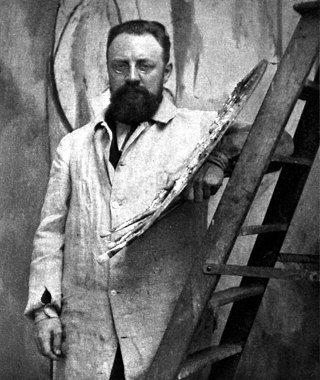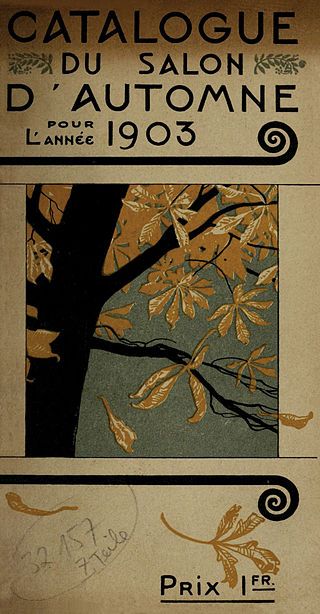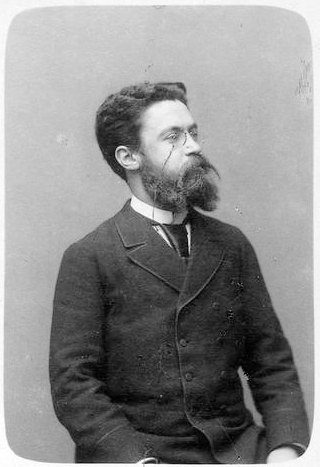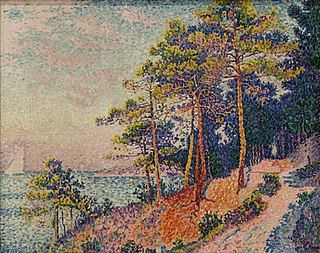
Henri Émile Benoît Matisse was a French visual artist, known for both his use of colour and his fluid and original draughtsmanship. He was a draughtsman, printmaker, and sculptor, but is known primarily as a painter.

The Salon d'Automne, or Société du Salon d'automne, is an art exhibition held annually in Paris. Since 2011, it is held on the Champs-Élysées, between the Grand Palais and the Petit Palais, in mid-October. The first Salon d'Automne was created in 1903 by Frantz Jourdain, with Hector Guimard, George Desvallières, Eugène Carrière, Félix Vallotton, Édouard Vuillard, Eugène Chigot and Maison Jansen.

Henri Matisse’s Jazz is a limited-edition art book containing prints of colorful cut-paper collages, accompanied by the artist's written thoughts. It was first issued on September 30, 1947, by art publisher Tériade. The portfolio, characterized by vibrant colors, poetic texts, and circus and theater themes, marks Matisse's transition to a new medium.

Dance (La Danse) is a painting made by Henri Matisse in 1910, at the request of Russian businessman and art collector Sergei Shchukin, who bequeathed the large decorative panel to the Hermitage Museum, in Saint Petersburg. The composition of dancing figures is commonly recognized as "a key point of (Matisse's) career and in the development of modern painting". A preliminary version of the work, sketched by Matisse in 1909 as a study for the work, resides at MoMA in New York, where it has been labeled Dance (I).

Georgette Agutte was a French painter.

Woman with a Hat is an oil-on-canvas painting by Henri Matisse. It depicts Matisse's wife, Amélie Matisse. It was painted in 1905 and exhibited at the Salon d'Automne during the autumn of the same year, along with works by André Derain, Maurice de Vlaminck and several other artists later known as "Fauves".

Woman Reading is an oil-on-board painting executed in 1895 by the French artist Henri Matisse. It is displayed at the Musée Matisse, in Le Cateau-Cambrésis, having been on loan from the Centre Pompidou since 2002. It shows a woman, dressed in black, seated and reading, with her back to the viewer, in the calmness of a somewhat cluttered room. Matisse incorporated a self-portrait into the painting in the form of a framed drawing hanging on the wall at the upper left.

Luxe, Calme et Volupté is a 1904 oil painting by the French artist Henri Matisse. Both foundational in the oeuvre of Matisse and a pivotal work in the history of art, Luxe, Calme et Volupté is considered the starting point of Fauvism. This painting is a dynamic and vibrant work created early on in his career as a painter. It displays an evolution of the Neo-Impressionist style mixed with a new conceptual meaning based in fantasy and leisure that had not been seen in works before.

Fauvism is a style of painting and an art movement that emerged in France at the beginning of the 20th century. It was the style of les Fauves, a group of modern artists whose works emphasized painterly qualities and strong colour over the representational or realistic values retained by Impressionism. While Fauvism as a style began around 1904 and continued beyond 1910, the movement as such lasted only a few years, 1905–1908, and had three exhibitions. The leaders of the movement were André Derain and Henri Matisse.

The Back Series is a series of four bas-relief sculptures, by Henri Matisse. They are Matisse's largest and most monumental sculptures. The plaster originals are housed in the Musée Matisse in Le Cateau-Cambrésis, France.

Marcel Sembat was a French Socialist politician. He served as a member of the National Assembly of France from 1893 to 1922, and as Minister of Public Works from August 26, 1914, to December 12, 1916.

Le Sentier des douanes is a Pointillist-divisionist oil on canvas painting by Paul Signac, measuring 72 by 92.5 cm. It shows the 'Sentier des Douanes', a seaside path in Saint-Tropez. The work now hangs in the musée de Grenoble, to which it was left in 1923 by Georgette Agutte and Marcel Sembat.

French visual artist Henri Matisse was known for his use of color and draughtsmanship. In the early 20th century, Matisse became a leader of the Fauvism art movement, which was an early movement in the broader Post-impressionist era.

Arab Coffeehouse, is an oil-on-canvas painting by French visual artist Henri Matisse. Produced in 1913, Arab Coffeehouse was part of a series of goldfish paintings that Matisse produced in the 1910s and 1920s.

Paysage marocain (Acanthes), also known as Moroccan Landscape (Acanthus), is an oil painting from 1912 by the French artist Henri Matisse. The painting is signed "Henri Matisse" in the lower left corner and has been in the collection of the Moderna museet in Stockholm since 1917.

Marguerite Reading (French - Marguerite lisant or The Reader is a 1906 oil on canvas painting by Henri Matisse of his daughter Marguerite, then aged 12. It was exhibited at the 1906 autumn salon, bought by Marcel Sembat. It is now in the Museum of Grenoble after being left to it as part of Sembat and his wife Georgette Agutte's collections in 1923.

Seated Nude or Pink Nude is a 1909 oil on canvas painting by Henri Matisse.. It is now in the Museum of Grenoble, to which it was left in the 1923 Agutte-Sembat legacy.

The Little Mulatta or The Moroccan Girl is a 1912 oil on canvas painting by Henri Matisse, now in the Museum of Grenoble, to which it was left in the 1923 Agutte-Sembat legacy.

View over the Bay of Tangier is a 1912 oil on canvas painting by Henri Matisse, showing Tangier and its port on the Bay of Tangier. It was left to the Museum of Grenoble by Marcel Sembat and Georgette Agutte in 1923, and still hangs there.

















